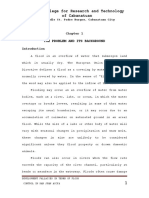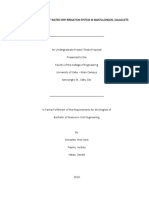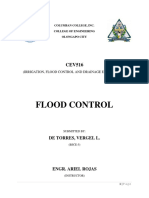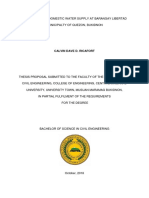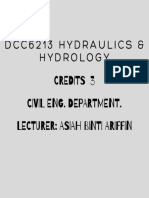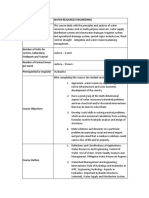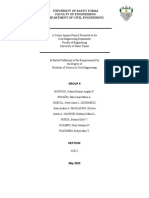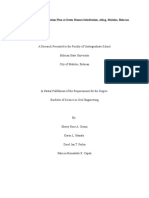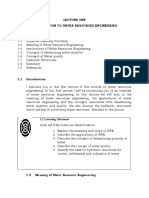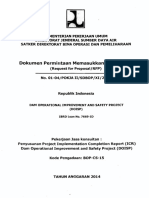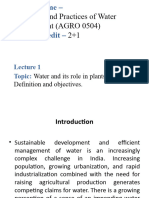ABEN 70a L2. Hydrologic Cycle
ABEN 70a L2. Hydrologic Cycle
Uploaded by
Joel GuanzonCopyright:
Available Formats
ABEN 70a L2. Hydrologic Cycle
ABEN 70a L2. Hydrologic Cycle
Uploaded by
Joel GuanzonCopyright
Available Formats
Share this document
Did you find this document useful?
Is this content inappropriate?
Copyright:
Available Formats
ABEN 70a L2. Hydrologic Cycle
ABEN 70a L2. Hydrologic Cycle
Uploaded by
Joel GuanzonCopyright:
Available Formats
Republic of the Philippines
CAVITE STATE UNIVERSITY
Don Severino delas Alas Campus
Indang, Cavite
COLLEGE OF ENGINEERING AND INFORMATION TECHNOLOGY
Department of Agricultural and Biosystems Engineering
ABEN 70a
BASIC FARM MACHINERIES, MECHANIZATION AND WATER MANAGEMENT
Name: Student Number:
Course, Year and Section: Date:
Laboratory Exercise No. 2
Hydrologic Cycle
I. OBJECTIVES
After this laboratory exercise, the student will be able to:
a. explain the concept of the hydrologic cycle,
b. apply the concept of the hydrologic cycle in a watershed approach; and
c. explain the factors that can affect the volume of water cycled in the hydrologic
cycle.
II. INSTRUCTIONS
1. Identify which major watershed your current residence is located here in Cavite.
Refer to the list below. To help you, you can open Google Maps in your phone,
and look for the general position of your residence then refer to Figure 1.
• Bacoor River Watershed: Bacoor, Imus, Dasmarinas
• Imus River Watershed: Kawit, Imus, Dasmarinas, Silang.
• San Juan River Watershed: Noveleta, General Trias, Dasmarinas, Silang.
• Cañas River Watershed: Tanza, Trece Martires, General Trias, Amadeo,
Silang,
• Labac River Watershed: Naic, Indang, Mendez, Tagaytay
• Maragondon River Watershed: Maragondon, Magallanes, GEA, Alfonso,
Indang
*If your place of residence is outside of the watersheds identified, you may
simply choose a watershed of your choice in the list above.
2. Referring again to Figure 1 below, identify bodies of water in your chosen watershed
such as river systems, lakes/ ponds, sea, etc. You can use a satellite view in Google
Maps (map type) for clearer identification.
3. List notable locations in your watershed such as industrial parks, farms,
subdivisions, mountains, etc that you think may affect the hydrologic cycle of the
chosen watershed.
4. In an A4 sized bond paper, draw the hydrologic cycle based on your watershed
showing the notable bodies of water and other places that can affect the transport
of water identified in step 3.
ABEN 70a – Laboratory Exercise No. 2
• Your illustration shall show the following processes: evaporation,
condensation, precipitation, runoff, evapotranspiration, groundwater flow.
5. Research for related literatures and answer the following guide questions.
Figure 1. Cavite Major River Watershed (Sedigo, 2017)
III. GUIDE QUESTIONS
1. Explain the relationship between weather and the hydrologic cycle.
2. Explain how water changes its state throughout the water cycle.
3. What is the function of a watershed?
4. Explain the effects of your identified notable locations in the watershed to the
volume of water cycled through the hydrologic cycle.
IV. INSTRUCTIONS FOR SUBMISSION
1. Format: A4; Arial; size 11; justified; in pdf file.
2. File name format: <section-surname-L2>
V. DOCUMENTATION
VI. REFERENCES
ABEN 70a – Laboratory Exercise No. 2
You might also like
- Water Resource ManagementDocument45 pagesWater Resource ManagementAndrick Alvarez100% (1)
- Body of The ThesisDocument50 pagesBody of The Thesisroneldayo62100% (1)
- LWUA Operation and Maintenance Manual PDFDocument433 pagesLWUA Operation and Maintenance Manual PDFRuby A. Quisay100% (1)
- Proposed A Drip Irrigation Water System Design in Mantalongon, Dalaguete, Cebu CityDocument51 pagesProposed A Drip Irrigation Water System Design in Mantalongon, Dalaguete, Cebu CityAnsil Jane Gonzales100% (3)
- Debarry Watershed Processes and MGMTDocument17 pagesDebarry Watershed Processes and MGMTJames K. KirahukaNo ratings yet
- Thesis Mo ToDocument38 pagesThesis Mo ToLester Ave BermidoNo ratings yet
- Top Roof Rain Water Harvesting (Isa Sunasara)Document38 pagesTop Roof Rain Water Harvesting (Isa Sunasara)Isa Sunasara67% (6)
- ABEN70a LR02 Briones Rachel DDocument5 pagesABEN70a LR02 Briones Rachel DRACHEL BRIONESNo ratings yet
- The Impact of Using Dam For Flood Control in The Philippines: A Case StudyDocument7 pagesThe Impact of Using Dam For Flood Control in The Philippines: A Case StudyJoshua Miguel BunoNo ratings yet
- SHESHDocument143 pagesSHESHsansay cagaananNo ratings yet
- Hydrology NotesDocument164 pagesHydrology Notespraneetha reddy100% (1)
- Ijias 18 239 01Document14 pagesIjias 18 239 01Fabrice AdingraNo ratings yet
- Final Requirement - Group6 - Salazar-Salipande-Senining-Waje-Valenzuela-ZaraDocument41 pagesFinal Requirement - Group6 - Salazar-Salipande-Senining-Waje-Valenzuela-ZaraMarz ValenzuelaNo ratings yet
- Classwork Assignment #1 Module 4Document7 pagesClasswork Assignment #1 Module 4Irene EstradaNo ratings yet
- Department of Civil Engineering: Project MembersDocument20 pagesDepartment of Civil Engineering: Project MembersKanhaiya BhagatNo ratings yet
- Thesis Aug 6.editedDocument7 pagesThesis Aug 6.editedChristian CazeñasNo ratings yet
- Irrigation (Flood Control)Document5 pagesIrrigation (Flood Control)Vergel De TorresNo ratings yet
- ATG General Physics 1 Week 1Document4 pagesATG General Physics 1 Week 1Richard PascuaNo ratings yet
- 422 Lab 4Document44 pages422 Lab 4Sunshine Evangelista PalmaNo ratings yet
- Water Management and Planning: October 2014Document84 pagesWater Management and Planning: October 2014rudratiwari2445No ratings yet
- Assessment of Domestic Water Supply at Barangay Libertad Municipalty of QuezonDocument18 pagesAssessment of Domestic Water Supply at Barangay Libertad Municipalty of QuezonEmanoAce100% (1)
- The Drainage System in Bula: Basis For The Development of A Flood ProgramDocument7 pagesThe Drainage System in Bula: Basis For The Development of A Flood ProgramLester Ave BermidoNo ratings yet
- DCC6213 1.0 IntroductionDocument22 pagesDCC6213 1.0 IntroductionZariff AnizanNo ratings yet
- Proposal - Lab - Environment - G4 EditedDocument40 pagesProposal - Lab - Environment - G4 EditedMuhammad Afiq Bin KamalNo ratings yet
- Assessment of Drainage Canal System Along Villarin Street, Mabolo Street, Max Suniel Street Carmen, Cagayan de Oro CityDocument28 pagesAssessment of Drainage Canal System Along Villarin Street, Mabolo Street, Max Suniel Street Carmen, Cagayan de Oro CityJohn Paul Niño Magos OrdenizaNo ratings yet
- Hydrology-Module 3-Phase 8Document3 pagesHydrology-Module 3-Phase 8nors lags100% (1)
- 3Document12 pages3baixar616161No ratings yet
- 2 Chapter 1Document10 pages2 Chapter 1Francis TampocoNo ratings yet
- 2 Distiller ThesisDocument94 pages2 Distiller ThesisPaul CamuNo ratings yet
- ATG General Physics 1 Week 3Document4 pagesATG General Physics 1 Week 3Richard PascuaNo ratings yet
- Final Edit WordDocument22 pagesFinal Edit WordJan TheGamerNo ratings yet
- Mirpur University of Science and Technology (Must), Mirpur Deparment Civil EngineeringDocument24 pagesMirpur University of Science and Technology (Must), Mirpur Deparment Civil EngineeringAbid HussainNo ratings yet
- Hydrologicand Hydraulic Analysisofthe Iponan River BasinDocument7 pagesHydrologicand Hydraulic Analysisofthe Iponan River BasinKennedy AlbaricoNo ratings yet
- WRE Course OutlineDocument2 pagesWRE Course OutlineJustine Anthony SalazarNo ratings yet
- CE-W1 Design Project 4C-Grp5Document37 pagesCE-W1 Design Project 4C-Grp5Rinalyn AsuncionNo ratings yet
- Chapter 1 2 Plag Check Damiles Et Al.Document16 pagesChapter 1 2 Plag Check Damiles Et Al.Vios, Allen Rafael M.No ratings yet
- Report Water Supply (GROUP B)Document30 pagesReport Water Supply (GROUP B)Samah AdamNo ratings yet
- Article 3Document13 pagesArticle 3lyalioubNo ratings yet
- A Proposed Flood Mitigation Plan at Desta Homes Subdivision, Atlag, Malolos, BulacanDocument25 pagesA Proposed Flood Mitigation Plan at Desta Homes Subdivision, Atlag, Malolos, BulacanSherry Gesim100% (1)
- 17CV73 Module 1 5Document115 pages17CV73 Module 1 5shivaraj salimathNo ratings yet
- Umar Mannir RawayauDocument30 pagesUmar Mannir RawayauabuberkerabdullerhiiNo ratings yet
- Earth and Life Science G11 Q1 W8 HydrometeorologicalHazardsDocument10 pagesEarth and Life Science G11 Q1 W8 HydrometeorologicalHazardsAna CristinoNo ratings yet
- Sea Water Converted Into Usable and Emergency Drinkable WaterDocument7 pagesSea Water Converted Into Usable and Emergency Drinkable WaterIJRASETPublicationsNo ratings yet
- Application of Geospatial Techniques For Hydrological ModellingDocument12 pagesApplication of Geospatial Techniques For Hydrological ModellingInternational Journal of Multidisciplinary Research and AnalysisNo ratings yet
- New Chapter 5Document16 pagesNew Chapter 5May Anne Lopez SyNo ratings yet
- Engineering HydrologyDocument8 pagesEngineering HydrologyBryan James Bigstone LadaranNo ratings yet
- Ecv 502 Wre Lecture OneDocument6 pagesEcv 502 Wre Lecture OneSymon KamenjuNo ratings yet
- EpanotDocument110 pagesEpanotKippy LeopNo ratings yet
- Chapter I RevisedDocument5 pagesChapter I RevisedVenedick SapongayNo ratings yet
- Solar Powered Field Server and Aerator Development For Lake PalakpakinDocument9 pagesSolar Powered Field Server and Aerator Development For Lake Palakpakindragh meh downNo ratings yet
- Publication MA3Document13 pagesPublication MA3lyalioubNo ratings yet
- Week 1 For CE37Document19 pagesWeek 1 For CE37joel lantongNo ratings yet
- Water Resources Engineering 2 1Document11 pagesWater Resources Engineering 2 1raianreyrNo ratings yet
- 5-Retention PondsDocument7 pages5-Retention PondsBondoc, Miles Jerome Z.No ratings yet
- CE5 1 GROUP 1 EDITED ANG YELLOW pt2 GrammarDocument60 pagesCE5 1 GROUP 1 EDITED ANG YELLOW pt2 Grammargex melchorNo ratings yet
- Lecture 3 - Water Sector ChallangesDocument14 pagesLecture 3 - Water Sector ChallangesMuneeb ArifNo ratings yet
- Beginner's Ultimate Guide to In-Ground Pool Maintenance: Tips to Keep Your Pool SparklingFrom EverandBeginner's Ultimate Guide to In-Ground Pool Maintenance: Tips to Keep Your Pool SparklingNo ratings yet
- Physical and Chemical Techniques for Discharge Studies - Part 1From EverandPhysical and Chemical Techniques for Discharge Studies - Part 1RB SalamaNo ratings yet
- Pictorial Presentation of WASH Activities in Rural KenyaFrom EverandPictorial Presentation of WASH Activities in Rural KenyaRating: 5 out of 5 stars5/5 (1)
- Dokumen Permiritaan Memasukkan Penawaran: Dam Operational Improvement An13 Safety Project (Doisp)Document9 pagesDokumen Permiritaan Memasukkan Penawaran: Dam Operational Improvement An13 Safety Project (Doisp)ajiNo ratings yet
- Ese 122P-2 E01 T1 Sy2223 Final Package - ResurreccionDocument10 pagesEse 122P-2 E01 T1 Sy2223 Final Package - ResurreccionMa. Lalaine Nicole ResurreccionNo ratings yet
- Bolgoda Lake - Tidal InfluenceDocument10 pagesBolgoda Lake - Tidal InfluencePriyashi WijeratneNo ratings yet
- Chapter-5 Indian Rivers and Water Resources: Choose The Correct AnswerDocument3 pagesChapter-5 Indian Rivers and Water Resources: Choose The Correct AnswerSALVE SHANKERNo ratings yet
- WATER EnvironmentDocument12 pagesWATER EnvironmentLance Hernandez100% (1)
- Ch3 Geo Test XDocument5 pagesCh3 Geo Test Xridaangupta240No ratings yet
- Irrigation and Drainage EngineeringDocument33 pagesIrrigation and Drainage EngineeringRaghu Nath PrajapatiNo ratings yet
- Answer 1:: CEL 212: Environmental Engineering Solution: Ion Exchange and Softening ++++++++example Questions++++++++Document4 pagesAnswer 1:: CEL 212: Environmental Engineering Solution: Ion Exchange and Softening ++++++++example Questions++++++++IshrakNo ratings yet
- Flooding ReportDocument3 pagesFlooding Reportapi-355774141No ratings yet
- বাংলাদেশ ভূমি পরিমাপের আদর্শ এককসমূহDocument31 pagesবাংলাদেশ ভূমি পরিমাপের আদর্শ এককসমূহmosammat sumaNo ratings yet
- Water Conditioning Process PresentationDocument27 pagesWater Conditioning Process PresentationKamran RanaNo ratings yet
- Omaya Report FinalDocument75 pagesOmaya Report FinalOmaya TariqNo ratings yet
- Daily Report Analysis Sea Water Reverse Osmosis & Log Sheet: Month TrainDocument10 pagesDaily Report Analysis Sea Water Reverse Osmosis & Log Sheet: Month Trainmahesa34No ratings yet
- Hydraulic Structure 2Document7 pagesHydraulic Structure 2Jl CarlNo ratings yet
- Lesson 1 1Document11 pagesLesson 1 1Narendra jaiswalNo ratings yet
- Malaysian Standard For Drinking WaterDocument24 pagesMalaysian Standard For Drinking WaterMugiwara No LuffyNo ratings yet
- External MBR Vs Internal MBRDocument8 pagesExternal MBR Vs Internal MBRwacsii ccasullaNo ratings yet
- Hydrologic RoutingDocument11 pagesHydrologic RoutingDaRwin EnriquezNo ratings yet
- Khairpur Nathan Shah ThreatenedDocument2 pagesKhairpur Nathan Shah ThreatenedMohammad JumanNo ratings yet
- Isla - E1 WATER SAMPLING HANDOUTDocument5 pagesIsla - E1 WATER SAMPLING HANDOUTCarissa IslaNo ratings yet
- Coastal Branch Aqueduct: California'SDocument2 pagesCoastal Branch Aqueduct: California'Smgf2335No ratings yet
- NY Dams 2010 NIDDocument86 pagesNY Dams 2010 NIDEmma YepsenNo ratings yet
- Hydrograph - Delos Reyes Rachel L.Document12 pagesHydrograph - Delos Reyes Rachel L.Rachel Delos ReyesNo ratings yet
- Munoz Et Al. (Final)Document10 pagesMunoz Et Al. (Final)emoelcapoNo ratings yet
- As'idatu Viddaroini - A - 195060401111009kelompok 5 LidDocument13 pagesAs'idatu Viddaroini - A - 195060401111009kelompok 5 LidAs'idatu ViddaroiniNo ratings yet
- HydrologyDocument34 pagesHydrologyMichaelViloria100% (1)
- TOTO Fitting Catalog October 2023Document108 pagesTOTO Fitting Catalog October 2023Patricia BellaNo ratings yet
- Week 3 Rough Draft of The Final Lab Report Kevin Marshall SCI 207: Our Dependence Upon The Environment Instructor: Oleg Maksimov 8 April 2017Document7 pagesWeek 3 Rough Draft of The Final Lab Report Kevin Marshall SCI 207: Our Dependence Upon The Environment Instructor: Oleg Maksimov 8 April 2017Alex MwasNo ratings yet
- Research Proposal ExampleDocument4 pagesResearch Proposal ExampleThokozani MgwalimaNo ratings yet

